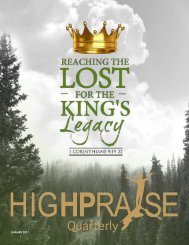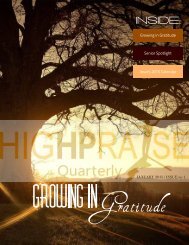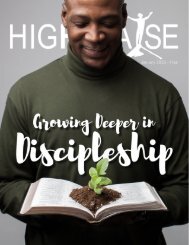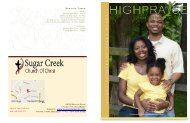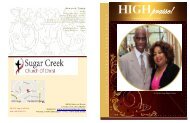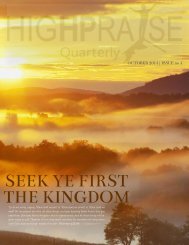Create successful ePaper yourself
Turn your PDF publications into a flip-book with our unique Google optimized e-Paper software.
The fourth pillar of the Restoration Movement was Walter Scott. Scott was also raised<br />
Presbyterian, but upon arriving in New York from Scotland, he became influenced by George<br />
Forrester. Forrester was part of the Scottish independent movement to restore the New<br />
Testament <strong>Church</strong>. Their doctrines included baptism by immersion, the Lord’s Supper every<br />
Sunday, and foot washing.<br />
Scott was baptized by immersion in 1819, but in 1821 he had also become convinced that<br />
baptism must be “for the remission of sins.” That is, he came to believe that baptism was not<br />
merely an ordinance or ritual, but a decision of the penitent to release God to wash away our<br />
sins—a formal remission.8<br />
In 1826 Scott attended a meeting of the Campbell’s association and became even more<br />
closely connected. Impressed with his preaching, the next year the association asked Scott<br />
to be become their evangelist. Through his preaching over the next three years, more than<br />
3000 converts were brought into the Stone-Campbell-Scott Movement. A central part of<br />
Scott’s message was that in order to be saved, one must have faith, repent, and be baptized<br />
for the remission of sins (Acts 2:38), and as a result God would provide that remission, the gift<br />
of the Holy Spirit, and eternal life.<br />
At that point, the Campbellite “reformers” became known as “Disciples.” The followers of<br />
Walter Scott joined together with them and with Barton Stone’s “Christians” in 1832. But<br />
about one-half of Stone’s “Christians” didn’t agree with the Campbell’s emphasis on the<br />
necessity of baptism by immersion for salvation (baptismal regeneration), and did not<br />
unite.10 The two merging groups adopted the Campbellite name, “Disciples of Christ” or the<br />
Stone preference, the “Christian <strong>Church</strong>.”<br />
Divisions<br />
The Stone-Campbell-Scott Movement has experienced numerous divisions in their attempts<br />
to restore what they view as pure New Testament Christianity. The schisms arose because<br />
invariably the practical question arises, “Who determines whose interpretations of the New<br />
Testament doctrines and practices are correct?” The issue always comes back to<br />
hermeneutics (applied rules of Bible interpretation).<br />
Lacking a sound hermeneutic, then, divisions resulted over issues like the use of instrumental<br />
music, the support of mission agencies, and how much understanding a baptismal candidate<br />
must have for effectual baptism, and even over whether or not previously baptized people in<br />
Baptist or other immersion churches would be allowed communion (Lord’s Supper) if they<br />
had an incomplete understanding of the necessity of baptism for salvation.<br />
Another divisive issue, introduced by Barton Stone, was the doctrine of the trinity. Stone<br />
interpreted the Holy Spirit as the power of force of God and concluded that the trinity was a<br />
man-made tradition. This legacy has had an impact on many <strong>Church</strong>es of Christ today. It is<br />
not unusual to encounter members who basically hold a view that the Holy Spirit and the<br />
Bible are inseparably linked. The only time the Holy Spirit is present is when the Bible is<br />
opened and read. It is almost like a genie in the bottle. When the Bible is closed, the Holy<br />
Spirit returns to the Bible.








